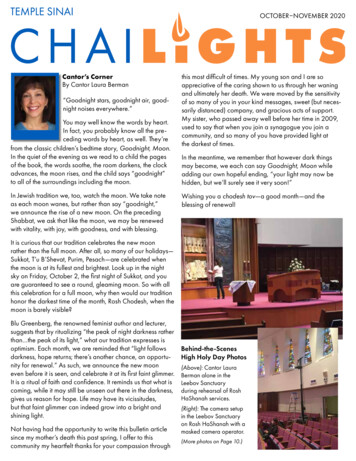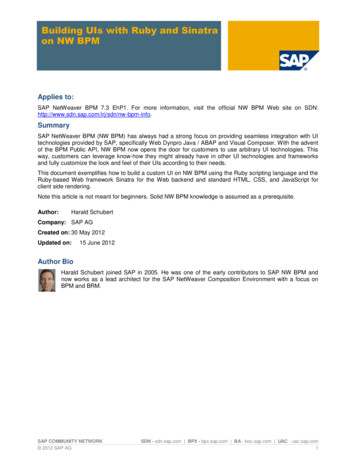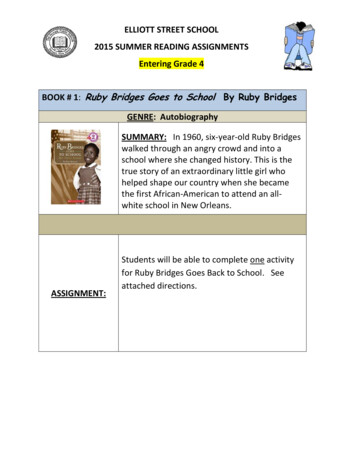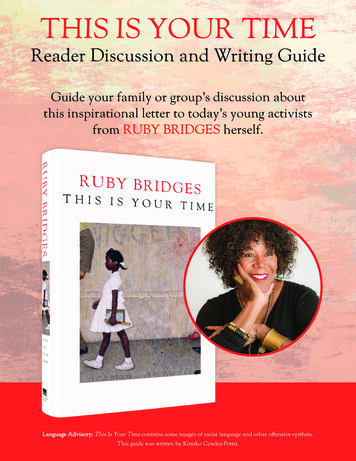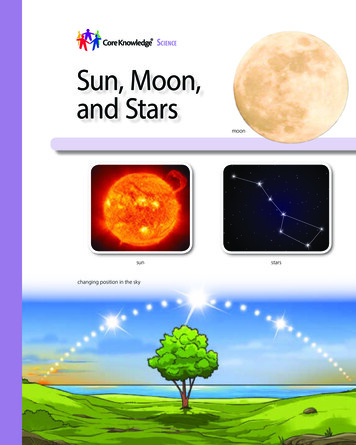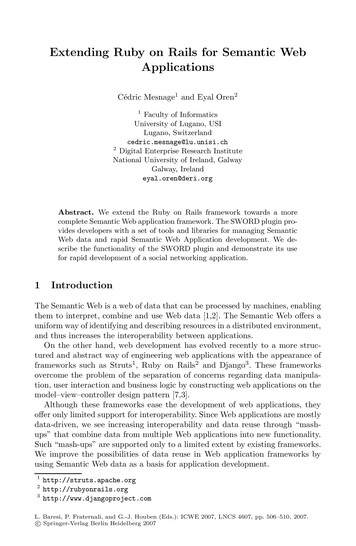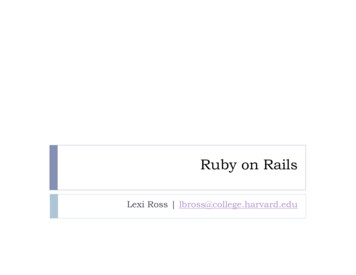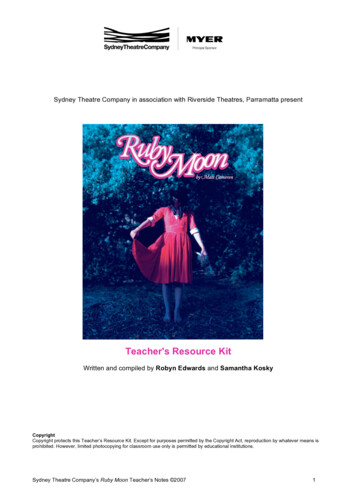
Transcription
Sydney Theatre Company in association with Riverside Theatres, Parramatta presentTeacher's Resource KitWritten and compiled by Robyn Edwards and Samantha KoskyCopyrightCopyright protects this Teacher’s Resource Kit. Except for purposes permitted by the Copyright Act, reproduction by whatever means isprohibited. However, limited photocopying for classroom use only is permitted by educational institutions.Sydney Theatre Company’s Ruby Moon Teacher’s Notes 20071
ContentsSydney Theatre Company3Sydney Theatre Company Education4Ruby Moon Production Credits5On line Resources5Artistic/Social/Political/Cultural Context6Traditional and Contemporary Practices and Conventions7Notes from Discussion with Designer, Jo Briscoe10Dramatic Structure and Form11The Prologue12The Epilogue13Characters14Transformation and Transition14Themes and Issues15Imagery15The Night and the Nightmarish World16The Mannequin17Sound17Performance Style (Absurd, Expressionist)17Post-Performance Essay Question18Sydney Theatre Company’s Ruby Moon Teacher’s Notes 20072
Sydney Theatre CompanySydney Theatre Company (STC) produces theatre of the highest standard that consistentlyilluminates, entertains and challenges. It is committed to the engagement between the imaginationof its artists and its audiences, to the development of the art form of theatre, and to excellence in allits endeavours.STC has been a major force in Australian drama since its establishment in 1978. It was created bythe New South Wales Government, following the demise of the Old Tote Theatre Company. Theoriginal intention was to better utilise the Drama Theatre of the Sydney Opera House and the newCompany comprised a small central administration staff, technical staff, workshop and rehearsalfacilities. Richard Wherrett was appointed Artistic Director from 1979 to 1990.The Wharf opened on 13 December, 1984 by Premier Neville Wran, which allowed all departmentsof the Company to be housed under one roof for the first time. The venue was to become the envyof the theatre world. From 1985, the Company could perform in two locations throughout the year,the Drama Theatre and The Wharf. From 1990 to 1999, Wayne Harrison served as Artistic Director.A third regular venue, Sydney Theatre, administered and operated by STC, opened in 2004.The predominant financial commitment to STC is made by its audience. Of this audience, theCompany's subscribers make a crucial commitment. The Company is also assisted annually bygrants from the Federal Government through the Australia Council and the New South WalesGovernment through the Ministry for the Arts. STC also actively seeks sponsorship and donationsfrom the corporate sector and from private individuals.Under the leadership Artistic Director Robyn Nevin, STC's annual subscription season features upto 12 plays including: recent or new Australian works, interpretations of theatrical classics andcontemporary foreign works. In addition STC regularly co-produces and tours productionsthroughout Australia, playing annually to audiences in excess of 300,000. STC actively fostersrelationships and collaborations with international artists and companies. In 2006 STC began a newjourney of artistic development with the inception of The Actors Company, the STC ensemble.To access detailed information on Sydney Theatre Company, its history and productionsplease contact our Archivist Judith Seeff at jseeff@sydneytheatre.com.auSydney Theatre Company’s Ruby Moon Teacher’s Notes 20073
Sydney Theatre Company EducationSydney Theatre Company is committed to education by programming original productions andworkshops that enthuse and engage the next generation of theatre-goers. Within the educationprogramme Sydney Theatre Company produces its own season of plays as well as collaborateswith leading theatre-for-young-people companies across Australia.Often a young person’s first experience of theatre is facilitated by teachers. STC ensures access toall of its mainstage productions through the schoolsday programme as well as produces and tourstheatre specifically crafted to resonate with young people.STC works to support educators in their Drama and English-teaching practices. Every year dynamicworkshops are held by leading theatre practitioners to support curriculum content, detailedresources are provided for all productions and an extensive work-experience programme isavailable to students from across the state.The annual Sydney Morning Herald and Sydney Theatre Company Young Playwright’s Awardcontinues to develop and encourage young writers. The winning students receive a cash prize anda two-day workshop with a professional director, dramaturg and cast – an invaluable opportunityand experience.Sydney Theatre Company has an extensive on-line resource for teachers and students. Visitwww.sydneytheatre.com.au/education.We encourage teachers to subscribe to regular e-news to keep informed as well as access heavilydiscounted tickets and special offers/For further information on STC Education programme, please contact the EducationManager Helen Hristofski at hhristofski@sydneytheatre.com.auSydney Theatre Company’s Ruby Moon Teacher’s Notes 20074
Production CreditsSydney Theatre Company in Association with Riverside Theatres, Parramatta presentRuby Moonby Matt CameronDirectorDesignerLighting DesignSound DesignerAndrew UptonJo BriscoeChris TwymanMax LyandvertPerformersJaime MearsJustin SmithStage ManagerAssistant Stage ManagerNicole RobinsonLiana SlussarefOn-line ResourcesSydney Theatre Company has built a new website dedicated to providing excellent resources forteachers and students. Visit sydneytheatre.com.au/education to access Ruby Moon resourceswhich include: Costume DesignsSet BoxProduction ImagesVideo of recorded interviewsMedia ReleaseStage Manager’s Rehearsal DiaryOpportunities for student feedback through ‘Your Say’Sydney Theatre Company’s Ruby Moon Teacher’s Notes 20075
Artistic/Social/Political/Cultural ContextCameron presents a contemporary Australian landscape of a tiny neighbourhood cul-de-sac, wherean ice-cream van plays Greensleeves, which becomes a vast wasteland of ambiguity.Exercise: Introduction to Contemporary Australian TheatreBRAINSTORM: What experiences of Australian theatre have you had? Define what makes all theseexamples “Australian”. What would you define as Australian theatre?Think about: images, characters, themes and issues, symbols and metaphors, language, setting andlandscape, cultural and political context, comedy and irony, atmosphere, element of biography andAustralian identity (Hint: If it was performed overseas how would other audiences identify it asAustralian AND when performed here what do Australian audiences identify with on a variety of levels?).Ruby sets of down cul-de-sac and never returns SYLVIE: We had a child, Ray. And we lost her.SCENE 7 pg 34The notion of the missing child is part of the Australian psyche as eg. Beaumont children, AzariaChamberlain, Picnic at Hanging Rock, and is presented as a recurring theme in the play. We areyoung nation, experiencing destruction and corruption of innocence. Cameron challenges theassumption that the street and the world we have created for ourselves is safe by cracking the idealsuburban image. We are led us to discover that the foundation of our existence - that our world issafe - seems no longer true. We are often described as fringe dwellers on edges of the islandscared of what lies at the centre of the continent. Ray and Sylvie want the truth but don’t want thetruth .Research and Discussion:Conduct research/web search into Australia’s missing children - newspaper articles / other texts / playsdealing with the issue e.g. Samantha KnightIdentify and discuss the fears, emotions and media hype that surrounds these stories and why “themissing child” has become such a fundamental part of Australian landscape and psyche.What fairytales can you think of that explore the premise and concept of the missing or lost child? Whatideas etc do these tales explore? What do they have in common? Why do you think this theme/premiseis so popular and recurring? Why is it often a little girl? Alice in WonderlandLittle Red Riding HoodHansel and GretelWizard of OzHow has Upton’s production provided a translation of the fears and emotions addressed in Cameron’stext?Sydney Theatre Company’s Ruby Moon Teacher’s Notes 20076
Traditional and Contemporary Practices and ConventionsNotes from an Interview with Andrew Upton, Director of Ruby Moon, STC 20071. What is it about Ruby Moon that appealed to you and made you want to direct it?Its theatricality first and foremost it possesses an openness that is attractive and it’s theopportunities it offers actors that I am interested in as a director. It’s much more about Ray andSylvie . so charged, so sexy. It’s an actor’s piece, beautifully written. We’re finding a lot more. Ithink it’s going to be very different.2. What can we expect from your interpretation of Ruby Moon for STC 2007? How differentdo you think it will be for those students who have explored it in the classroom?A very different setting; the set is very different from what is described . Many objects are notincluded. The designer and I thought, “Let’s get rid of the props except those related to thecharacters”. The imagery of the nursery, the dusty house is gone. The play is stripped bare; we’veonly kept the essentials. A Hills hoist is used to change scene sound is huge . drains [areimportant to the concept].3. Do you see the play as uniquely Australian or does it have universal resonance?It’s a very Australian play with a strong suburban feel. I would imagine that it would play anywhere,as the central relationship between Ray and Sylvie at the core of the play is a true marriage.The characters are kind of Australian.Dulcie is a kind of Patrick White character.It would play out well in an American landscape. The “missing child” is a terrible basis for quite afunny play.There are some answers. There is a clear answer in our production that a child existed. They havegot to have had that child in that relationship.4. Coming to this production as the director, how has your other theatre role as playwrightinfluenced your relationship with the text?It’s a really good bit of writing. Cameron creates an imaginative world that is justified which is verydifficult to sustain in writing.I’m more Naturalistic than Cameron, particularly in dialogue. He’s prepared to break theatrical formand integrate why he’s drawn it into the meaning of the play. He provides the characters with a wayof acting out their fantasies.Every story has a moment where it can go to shit. Keeping the mystery alive that these neighbourscould be truly neighbours rather than fantasies working out how to jump over them - there aremoments in nearly every script where you have to make a leap and the actors are required to justifycertain actions without reason but they are not here. Cameron’s writing made the play veryattractive to direct.Sydney Theatre Company’s Ruby Moon Teacher’s Notes 20077
5. What images and ideas in Ruby Moon have influenced your direction?The melting ice cream cone.sound hugely.fairytale this thing that’s evolved. The kiss, theconstant kiss, “Can I have a kiss?”. The sexual relationship of marriage equals the spine of the play.We’ve pushed this through to characters they play. It’s really sad. There is an interesting tension.There’s great comedy, classical great comedy, double takes and slapstick, juxtaposed with realisticgrief.6. Cameron’s play evokes the sense of an unknown threatening landscape. How have youused space and/or design to recreate this in the theatre?They are playing this interior life at the end of a cul-de-sac. It’s disconcerting, placing it in the cul-desac, placing it in a dangerous space; threatening in the shape of it, jagged and tooth-like with noway out. A strangely blank, threatening blackness in people, the world.like you’re dreaming. It’sclaustrophobic; you can’t get free of it.David Lynch-like. It’s a hard-edged, Godot/Beckett aesthetic.There’s a chest for the actors to play with.7. There are specific production and design directions specified by Cameron in the script.Can you describe the design choices you have made and your relationship with yourdesigner, Jo Briscoe?We worked collaboratively. We started with dialogue, threw out props. We had meetings anddiscussion and decided to strip away everything. Wherever we want to put it, that’s the core ofwhere we started. The process goes in stages.Very early on we got fixated on a cone melting into the pavement. The cone led to bitumen. Thingsgrow. The play needs a designer.8. What performance style or styles have you been exploring or uncovering with youractors in rehearsals?The play seems to say the style required by each moment but it is firmly based in reality. Forexample with Sonny Jim.this is what this guy believes. It’s the reality of a life. These people do thisbecause that’s how they see themselves.When actors play each moment straight the impact is much stronger, it carries more weight. Wehave used tones from the archetypes but not the clowning or the torch song as directed in the script.To keep the mystery alive, the neighbours must be played by the actors as if they are real people.The character’s natures are Naturalistic with a back-story and a history. Emotions, conversations,decisions must be played as if people really do these things and have these behaviours.9. Two actors play all the roles, what rehearsal techniques or exercises have you used tohelp the actors find their characters?We are milking it as a practical exercise. No one is saying “stand there do this”. We are not aimingfor a final image. We’ve got a very practical edge so it doesn’t get lost in the madness or becometoo stylised. There is a very practical aesthetic – we work out the mechanics of how a scene needsto run which opens up a set of choices and then we start to colour in and get shapes, textures.then it shifts.Sydney Theatre Company’s Ruby Moon Teacher’s Notes 20078
10. Cameron’s writing style is quiet poetic, what techniques have you used to make this liveon stage?How this works as dialogue, it’s not realistic dialogue in a classic sense.there’s a rhythm.it’sconnected. What we level of reality/fantasy are they connected to on each line? There are aboutseven realities and it starts to play as a piece of dramatic text.11. What do you see is at the heart of Ruby Moon?I would have said grief. Also I think it’s a marriage, a relationship in stasis.12. Do you have your own thoughts about / opinions on what happened to Ruby or do yousimply surrender to the journey Ray and Sylvie are on?We surrender because we are fascinated. This is terrible, something horrible has happened. Theyhave no place in it.not knowing.if they could just find out if she is dead. She does exist.Everything that happens on stage has a reality.Sydney Theatre Company’s Ruby Moon Teacher’s Notes 20079
Notes from Discussion with Designer, Jo BriscoeI had already read the play before coming on board with this production and loved it. I was excitedby design possibilities.We started talking about images we thought we had.the imagery wasn’t written. The image ofabandonment is a tragic image. The design needs to have a demented edge. We were influencedby Cameron’s introduction to living in the suburbs, you think you are safe, but they are not.that isinherent in suburbia.We began with a list of all the images in the play on paper. It’s a circular action.continually goingthrough them. This equals the cul-de-sac. Once you get it it’s very quick.There are real props and they are part of the action. There is also the notion of dress up box.theconcept of the neighbours as dolls. Cameron puts us into a place that is not part of our reality.Having the idea of the dress up toys/dolls/box led us to the doll’s clothes out of scale with bigbuttons. Velcro is like some kind of doll. It won’t be immediately evident that the scale is out, but it’sapparent and gets more noticeable. The giant press-stud sells it.The props are toys. Things that are part of the adult world, those things used by characters tomedicate themselves are real e.g. medicine, pill bottle, as they are connected to the reality of theirlife compared to what they are acting out in their grief spiral. There needs to be a contrast. We areplaying with scale, relative to each other; to normal.all of the clothes, houses, Hills Hoist.anadjunct of how things meet each other leads to contrast.The characterisation in the script, the theatrical conceit of the actors playing the neighbours gives uslicense to do things that are nutty. The neighbours are artificial, a little like the “Stepford Wives” andvery disconcerting. A slick plastic world that is artificial.Sydney Theatre Company’s Ruby Moon Teacher’s Notes 200710
Dramatic Structure and FormExercise:Divide class into groups and give each group a length of rope or string. Under a time limit, to increaseenergy and sense of competition, ask students to replicate/model the following dramatic structures onthe floor. Discuss the results/decisions between each one. Naturalistic/Realism dramatic structureAbsurd dramatic structureEpisodic dramatic structure, fractured narrativeRuby Moon is a fractured fairytale. The dramatic structure is cyclical and episodic. The audiencewitness Ruby’s parents experience grief and replay investigations like a routine in an effort the numbthis grief. In what began as a series of monologues in rehearsal, the audience travel with the Moonsthrough the cul-de-sac as they re-interview all the neighbours. Each neighbour implicates the nexttherein propelling the narrative; consequently the plot becomes a journey of tension.The play is episodic in that it is a series of short, somewhat self-contained scenes; each scene hasits own narrative and complication. However, with each scene the tension builds and the action risesand thus; it is at the end of the play the audience see the deeper mystery and bigger idea of grief.Cameron uses the play’s structure and narrative style to allow the character of Ruby to have a“voice” but she does not exist on stage. The dramatic technique of language is manipulated so thatshe is spoken about but never speaks.RUBY: [voice over] It begins like a fairytale suggests a journey, with recognisablecharacters, status relationships, fate and events but happy ending seems ambiguous.Whilst each scene can be experienced as a self-contained dramatic moment, it is when they areviewed within the context of the whole play that our knowledge and understanding of the charactersand the neighbourhood becomes more intriguing and engaging in its mystery and atmosphere.The constant change in locations creates a distorted narrative; a world that is larger than life. Rayand Sylvie search different sides of the street and emotionally and intellectually they aredisconnected and searching for different things and hear different things in what the characters say.When Ray and Sylvie return they do not share their discoveries with each other. They cannotresolve or reconcile, they are stuck but the audience can see they must move on in order to burytheir grief.DULCIE: You have to let it go. There is evil in this world, Raymond. Do you really want to bethe shattered couple in number one for the rest of your lives?The episodic structure enables time to jump between past and present, place to shift withoutchanging set, rhythm to rise and fall without losing the underlying tension. It allows a wide range ofcharacters as each episode can involve new characters without needing to introduce themthoroughly. Cameron’s structure thus relies on audience to make connections between the scenes.Each send ends on lingering image or idea. For example: Scene 1 - DULCIE: [As the parrot] Aark,where’s the pretty girl ?; Scene 2 – They form a family portrait behind the mannequin as they stareout; Scene 3 – The Ruby mannequin stands under street light with the moon hovering; Scene 5(original text) – Blackout. The sound of Ruby singing her scales.Sydney Theatre Company’s Ruby Moon Teacher’s Notes 200711
Discussion Questions:PLAYWRIGHT’S NOTE: The play runs strictly without interval.1. Why?2. How does the dramatic structure allow the characters to be played by TWO actors? How is itlike a traditional fairy tale narrative? What is the impact in Upton’s production?3. How does Upton in his direction of Ruby Moon, sustain the tension of the journey between andduring scenes when the nature of Cameron’s text allows only a short and ambiguousexploration of each character?4. How does Upton’s use of the episodic structure place emphasis on the search and the journeyfor Ray and Sylvie rather than on the character of Ruby?5. What dramatic choices does Cameron make to create this focus and how has Upton translatedthese for performance?The PrologueThe play consists of a Prologue and Epilogue and 10 scenes. The Prologue’s function is to introduceall the characters through the suspicious of Sylvie and Ray. The Prologue is a series of routines andrituals and sets up the repeated door knocking. Cameron manipulates the dramatic technique oflearning about other characters through what characters say about them and then manufactures theposition in which audience is placed. The audience is already positioned to judge the characters withsuspicion based on the Moon’s experiences and notions of their existence, as we move through thescenes.RAY: (Sid) He was bothering the customers.SYLVIE: (Sonny Jim) Walking that nasty dog of his (Dawn’s house) Bad things happen inhouses like that.RAY: They bring down the street.SYLIVE: Such a pretty little street.RAY: (The Wizard) I thought I saw him loitering in front of the school We don’t know at this point, who is right or wrong, Ray or Sylvie. The paper package is the link fromdiscussing past and memory and what they know, to present a new justification for re-run. Thepackage becomes a dramatic device to propel the action and accusation. It allows audience to makeconnections between Sylvie’s behaviour and Ray’s question, “What happened today?”Discussion Questions:Why is it called Prologue and not Scene 1? What is its dramatic function? Where does it position theaudience? From Ruby’s opening statement how quickly do things begin to unravel in the Prologue?If appropriate, compare to the Prologue of The 7 Stages of Grieving.Exercise:Divide the prologue into beats to find shifts in mood and to map the breakdown of the Moons fromsitcom perfect husband and wife to bitter, judgmental and righteous, dysfunctional couple. Look forrhythms in dialogue etc. Initially two students present the perfect couple in the arrival. Then studentsin pairs work on chosen sections to present the breakdown.Sydney Theatre Company’s Ruby Moon Teacher’s Notes 200712
The EpilogueThe Epilogue begins with the uncomfortable image of Ray on the armchair, normally Sylvie’s place,with a headless Ruby Doll and the disturbing soundscape of Ruby’s creepy voice from opening ofthe play, “It begins as a fairytale but how does it end?” The image helps to suggest to audience thatplay is reaching its resolution, as the structure seems to have come full circle, with Absurdist-likequalities. Ray continues to appear to have taken Sylvie’s place, telling the doorknocker to go awayand repeating the routine of looking under the floor.Sylvie appears dressed as Ruby, after a subtle prompt from Sylvie Ray seems to play along with thegame. The audience is alienated, repositioned, as we are unsure if Ray is engaged by Sylvie orpretending. We are watching another performance within the performance.Discussion Question:Is this an extension of the whole play, part of the repeated routine or has the search, questioningfinally driven them to this for the first time? Read Upton’s discussion on the existence of Ruby. What isyour conclusion?Exercise:Divide class into pairs and provide a short extract from the Epilogue for each pair to direct and perform.Half of the pairs should rehearse and perform the extract as ‘a return to life as it was in the Prologue’.The other half are to make choices about blocking, acting style and use of space to suggest Ray andSylvie have slipped into a much darker, nightmare-like place.Symbolperformancesand Visual MetaphorPresentand conduct class debrief: Which directorial choice do you think is the mostengaging way to end the play? Justify your thoughts with reasons and examples from theperformances presented in the workshop.Exercise: Directorial Interpretation & Stage DirectionsResources: Provide pairs with a section of the Prologue and Epilogue with stage directions.Provide other pairs with same section of script with all stage directions deleted.Rehearse the scene you have been given, paying particular attention to decisions you have madeabout movement & stillness, gesture, focus & tension, pause & silence, use of props and acting style.Reflection:In your logbook, reflect on your workshop experience by answering the following question:A director has a responsibility to obey the playwright’s stage directions in order to bring the play to lifeand create dramatic meaning.Evaluate the accuracy of this statement with reference to the performances of the Prologue andEpilogue you have seen in class.Sydney Theatre Company’s Ruby Moon Teacher’s Notes 200713
CharactersApart from the Moons, each character is given a name and a role, in Brechtian fashion. Camerongives each a significant prop e.g. stones out of shoe, birdcage, gun, bottle of booze. These propsbecome a theatrical and dramatic technique in forming part of the outer layer of the characters’identities. Each has their cross to bear e.g. Jimmy’s limp isn’t getting better.Each character creates their own ending for Ruby, based on their experiences and understanding ofthe world and project this imagined ending onto the story. The audience then draws on their socialand cultural context to answer what we believe has happened to Ruby.Exercise:Several of the characters have a routine that they “perform”. Identify what these are. Choose one anddiscuss what the performance reveals about that character. What is the other character’s reaction tothe routine as the performance takes place? This is as important as the character itself incommunicating to the audience what is real or not real as it can position us to view the character in aparticular way.In the STC production, how are we positioned by Upton to judge the characters of the neighbours?Transformation and TransitionExercise:Resources: range of props (female characters) boas, medicine bottles, elastic bands, shawl, birdcage,dolls, wigs, (male characters) crutch, rifles, etc. Exploring the characters through transformation, eachstudent needs 4 props.Present the female characters through the chosen prop, a distinct voice and physicality, and way ofmoving. Teacher directs students to establish an “arena” and feeds various character key lines to thestudents who experiment with delivery and elements of drama to find ways of presenting thecharacters. Students should be encouraged to remove the prop in character, returning to neutral andthen moving to the next character. Students should remain aware that an audience is watching at alltimes. Side-coach: For example, “You are the archetype – you are the “spinster”, the femme fatale.Use your prop to help in your movement.” Encourage the students to connect movement with breathand voice and the character’s movement centre and stance.Sydney Theatre Company’s Ruby Moon Teacher’s Notes 200714
Exercise: Character transformationImagine you have been cast by a director, as either Ray or Sylvie.To assist with your character development, your director has instructed you to write a characterbiography for one of the neighbours into which you transform. As the actor required to present thischaracter on stage, you must know and understand him/her intimately and be prepared to improvisevarious scenarios. For example: Sid and Veronica meet under the street lampDulcie stopping Carl outside the churchDawn meeting Sonny Jim on the way back from the post office with a packageThemes and Issues KnowledgeLight vs darkLossGuiltFear of the unknownInnocence vs loss of innocenceGriefTruthPowerlessnessSuburban life and neighbourly behavioursIdentityParent/child relationshipsImageryExercise:In pairs, list all the unsafe images referred to in one scene. Read these out to the class.In groups, select 3 unsafe images to bring to life. Consider how you might use sound, movement, theperformance space and/or interactions with the audience to create a particular environment oratmosphere.How does Upton deal with these images in his production and to what effect on the audience?Sydney Theatre Company’s Ruby Moon Teacher’s Notes 200715
The Night and the Nightmarish WorldDiscussion Questions:Accessing the STC website at p look at picture ofmodel box and describe the design concept and, look and feel of the set. What is being communicatedthrough the design and theatrical choices in Upton’s production?What lighting choices are evident in Upton’s interpretation of the text? In particular, how has Uptonbrought to life the lines of dialogue about night and/or made you aware that the action is occurring atnight? What is the thematic and metaphorical importance of this discovery? How does Upton interpretthe solitary spotlight (streetlamp), in particular?What audience response do these production and design elements provoke?How does the use of pre-recorded soundscape to communicate ideas?Exercise:On a piece of blank A4 paper or in your logbook, draw a picture of the perfect/fairytale cul-de-sac street.Photocopy or repeat the drawing distorting the fairytale featur
Ruby sets of down cul-de-sac and never returns É SYLVIE: We had a child, Ray. And we lost her. SCENE 7 pg 34 The notion of the missing child is part of the Australian psyche as eg. Beaumont children, Azaria Chamberlain, Picnic at Hanging Rock,

